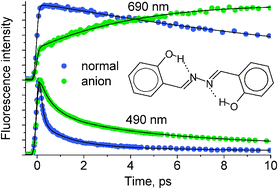What is the difference between the dynamics of anion- and keto-type of photochromic salicylaldehyde azine?†
Abstract
The normal and anion structures of

* Corresponding authors
a
Departamento de Química Física, Sección de Químicas, Facultad de Ciencias del Medio Ambiente, Universidad de Castilla-La Mancha, Avda. Carlos III, S.N., 45071 Toledo, Spain
E-mail:
Abderrazzak.douhal@uclm.es
Fax: +34 926 268840
Tel: +34 925 265717
b Quantum Electronics Laboratory, Faculty of Physics, Adam Mickiewicz University, Umultowska 85, 61-614 Poznan, Poland
The normal and anion structures of

 Please wait while we load your content...
Something went wrong. Try again?
Please wait while we load your content...
Something went wrong. Try again?
M. Ziółek, M. Gil, J. A. Organero and A. Douhal, Phys. Chem. Chem. Phys., 2010, 12, 2107 DOI: 10.1039/B920951D
To request permission to reproduce material from this article, please go to the Copyright Clearance Center request page.
If you are an author contributing to an RSC publication, you do not need to request permission provided correct acknowledgement is given.
If you are the author of this article, you do not need to request permission to reproduce figures and diagrams provided correct acknowledgement is given. If you want to reproduce the whole article in a third-party publication (excluding your thesis/dissertation for which permission is not required) please go to the Copyright Clearance Center request page.
Read more about how to correctly acknowledge RSC content.
 Fetching data from CrossRef.
Fetching data from CrossRef.
This may take some time to load.
Loading related content
